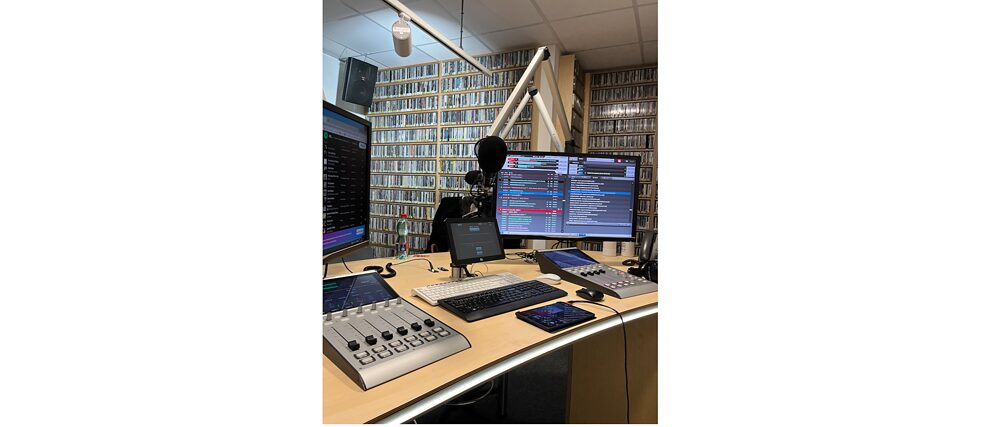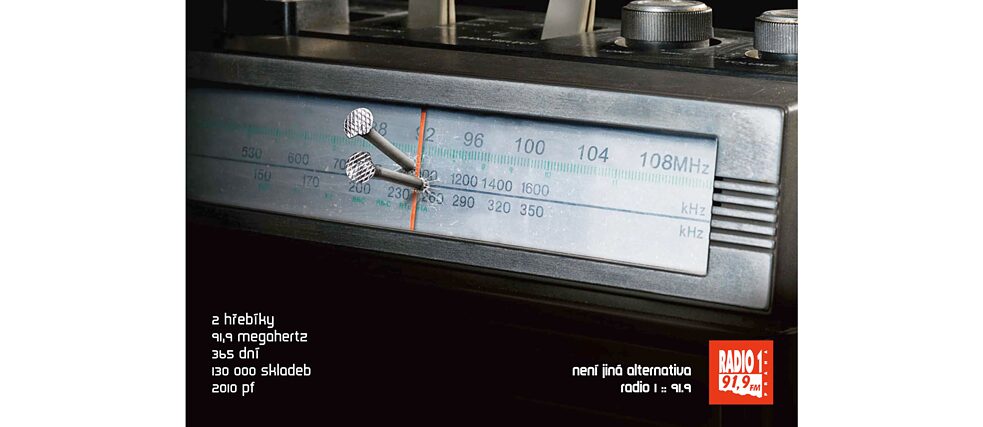Eastern Europe
Long May It Continue

Public and commercial radio stations dominate the world of broadcasting. But there’s more to radio than mainstream music and politically suitable content: some independent radio stations have made a difference in Central and Eastern Europe – and their power is still strong.
By Jana Kománkova
The world has changed a lot since 1923. Things that were new then are now commonplace, such as insulin treatment, helicopters and one-piece swimsuits. And also radio. 100 years after the first radio broadcast in many European countries, this medium is still going strong. Smaller stations in particular, which cater for an enthusiastic audience, are often well-loved by their listeners.
A Smorgasbord of Radio
There are different ways to run a radio station. The two most common types are the state-owned public service radio stations, and private ones. The private stations often belong to companies that own various other types of media, such as TV stations or newspapers. Often the management has a say in how the station operates – in terms of both budget and content. These stations are using a tried-and-tested formula to determine what music is played as well as the overall vibe: “oldies” stations play 1950s to 1970s pop music, while city stations are geared towards the younger audience in an urban demographic, for instance. This makes certainly sense from an economic perspective, but at the same time it may seem a bit cynical – especially bearing in mind that the stations use playlists created by people who aren’t necessarily lovers of the music, they just know what will work. Aren’t there other ways to exploit the radio format?
Yes, there are: There are stations that defy these principles of supposedly successful broadcasting. Instead of fulfilling a set role and as a worst-case scenario merely fleshing out the bones of the adverts, they tend to concentrate on being genuine, on delivering interesting music and discussion topics – including the more controversial and painful ones. There are not many of those stations in the world though. I have been a part of one such unicorns called Radio 1, based in Prague, for 30 years, and whenever I talk to people from other places, I get the response “oh we don’t have radio like that where I come from”.
In my experience, broadcasters that provide material above and beyond what the audience accepts unquestioningly play a special role in the cultural field and can enrich it tremendously. It is just not easy to run them because producing radio programmes is relatively costly, advertisers want results, and those stations are often too small to attract interest from big brands. However it is possible, and it can play a role in history: some Central European radio stations are more than just radio. I’d like to introduce some of them to you.
From Pirates to Independents
 Workstation Radio 1
| Foto (Detail): © Jana Kománková
Radio študent – a student radio station founded in 1969 in Serbia – played an important political role in the former Yugoslavia before the regime of Josip Tito and his successor Ivan Stambolic fell in 1987. Igor Vidmar, a legendary music promoter from Ljubljana, used to be a part of it. “Radio študent was popular beyond its catchment area,” recalls Vidmar. Its music programme inspired the state radio to create a rock programme that is still very popular to this day. “Radio študent missed the boat with the advent of punk,” complains Vidmar, however. “I actually heard the Sex Pistols for the first time on state radio.” The role of the radio station extended far beyond the scope of music though. It broadcasted a lot of political content in the 1970s that public radio would not, and helped establish plurality of opinions and freedom in general. Vidmar also recalls “state radio’s inherent delay” – meaning that the “live” broadcast was always slightly behind real-time to allow censoring of any politically “incorrect” content. Radio študent did not have such a delay: it was tied to a university, so the authorities could not just stop it.
Workstation Radio 1
| Foto (Detail): © Jana Kománková
Radio študent – a student radio station founded in 1969 in Serbia – played an important political role in the former Yugoslavia before the regime of Josip Tito and his successor Ivan Stambolic fell in 1987. Igor Vidmar, a legendary music promoter from Ljubljana, used to be a part of it. “Radio študent was popular beyond its catchment area,” recalls Vidmar. Its music programme inspired the state radio to create a rock programme that is still very popular to this day. “Radio študent missed the boat with the advent of punk,” complains Vidmar, however. “I actually heard the Sex Pistols for the first time on state radio.” The role of the radio station extended far beyond the scope of music though. It broadcasted a lot of political content in the 1970s that public radio would not, and helped establish plurality of opinions and freedom in general. Vidmar also recalls “state radio’s inherent delay” – meaning that the “live” broadcast was always slightly behind real-time to allow censoring of any politically “incorrect” content. Radio študent did not have such a delay: it was tied to a university, so the authorities could not just stop it.
 The old days of broadcasting history sometimes included (a lot of) red wine.
| Photo (detail): © Jana Kománková
The former Eastern bloc has seen more dramatic moments in radio history. Some started as pirates. That was the case with Radio 1 too. “They did not set out to be pirates but there was no law to govern radio broadcasting,” recalls Vladimír Vintr, the former director of Radio 1 in Prague, which was known as Radio Stalin back then. “We tried to get the authorities to grant us a licence. The original plan was for it to be official, not that it would be a pirate station,” says Lenka Wienerová, the current director of Radio 1, about the early days. But it took ages to get the licence, and so the students decided to try broadcasting as a part of an art exhibition held in the dirty, dusty catacombs under the former Stalin monument in Prague’s Letná. The broadcasting equipment was seized after three days of pirate broadcasting in autumn 1990 and it took a lot of petitions, open letters and pressure – mainly from the art scene – to get it back. However, thanks to Vintr and other enthusiastic radio creators, eager musicians and artists who wrote fierce letters to the media, the station was finally allowed to broadcast legally.
The old days of broadcasting history sometimes included (a lot of) red wine.
| Photo (detail): © Jana Kománková
The former Eastern bloc has seen more dramatic moments in radio history. Some started as pirates. That was the case with Radio 1 too. “They did not set out to be pirates but there was no law to govern radio broadcasting,” recalls Vladimír Vintr, the former director of Radio 1 in Prague, which was known as Radio Stalin back then. “We tried to get the authorities to grant us a licence. The original plan was for it to be official, not that it would be a pirate station,” says Lenka Wienerová, the current director of Radio 1, about the early days. But it took ages to get the licence, and so the students decided to try broadcasting as a part of an art exhibition held in the dirty, dusty catacombs under the former Stalin monument in Prague’s Letná. The broadcasting equipment was seized after three days of pirate broadcasting in autumn 1990 and it took a lot of petitions, open letters and pressure – mainly from the art scene – to get it back. However, thanks to Vintr and other enthusiastic radio creators, eager musicians and artists who wrote fierce letters to the media, the station was finally allowed to broadcast legally.
 Radio 1 even has its own slipmats, a see-through vinyl shows them.
| Photo (detail): © Jana Kománková
Radio 1 became the first private radio station in Bohemia, and others were to follow. Even though the Czech Republic and its market is small, the station runs at a profit today, and makes enough money to keep on going. What is special about Radio 1, for instance, is that there is no morning show as we know it. But there are more than 100 DJs currently active: its programming resembles the specialist evening shows broadcast by other stations in terms of content and passion. People often play their shows entirely from their own music collections, bringing their treasured vinyl to share with listeners. The passion radiating from the creators can be heard, and the listeners cherish it – thankfully, the advertisers do, too. And yes, it is a special feeling to play a 10-minute track by the Einstürzende Neubauten at 7 am.
Radio 1 even has its own slipmats, a see-through vinyl shows them.
| Photo (detail): © Jana Kománková
Radio 1 became the first private radio station in Bohemia, and others were to follow. Even though the Czech Republic and its market is small, the station runs at a profit today, and makes enough money to keep on going. What is special about Radio 1, for instance, is that there is no morning show as we know it. But there are more than 100 DJs currently active: its programming resembles the specialist evening shows broadcast by other stations in terms of content and passion. People often play their shows entirely from their own music collections, bringing their treasured vinyl to share with listeners. The passion radiating from the creators can be heard, and the listeners cherish it – thankfully, the advertisers do, too. And yes, it is a special feeling to play a 10-minute track by the Einstürzende Neubauten at 7 am.
In Austria there were pirate stations at the end of the 1980s, challenging the situation that the broadcasting scene was monopolised by the public broadcaster (ORF). Nowadays Vienna has the community radio station Orange 94.0, and there are 13 other community stations across Austria. Community radio is actually the rarest type of radio station: they are usually nonprofit, community-oriented, politically independent and aim to cover topics and musical styles that are not mass-media friendly. The value of such stations, although they are very rare, is immense. The listeners feel as though they are part of a community and the content is more relevant to their everyday lives than anything the larger commercial stations can offer. Interestingly, the fight against the broadcasting monopoly was harder in Austria than in other countries, and, according to the Verband Freier Rundfunk Österreich, “a complaint against the broadcasting monopoly even reached the European Court of Human Rights. In November 1993, the Court declared that the broadcasting monopoly did indeed interfere with the right to disseminate information and ideas.”
Internet or Not?
 Advertisement Radio 1
| Photo (detail): ©Jana Kománková
Running an FM radio station is quite expensive and some time ago it seemed that internet radio is where it’s at: paying for the actual broadcasting seemed obsolete for some. There is a vast array of software available for those who want to broadcast digitally so it seems quite easy to start. However, paying all the necessary fees to the copyright organisations is a costly exercise. This makes the whole project considerably more difficult: you pay thousands for just playing songs online to ten people. You can’t even really be a pirate anymore, even on the internet: thanks to current software it’s easy to spot those that broadcast illegally. Furthermore, you either need to be wealthy enough to pay for everything yourself (and to send your playlists to the copyright organisations which is a lot of typing) or you have to carry a significant amount of advertisement: and who would pay for advertising in a medium if nobody is listening?
Advertisement Radio 1
| Photo (detail): ©Jana Kománková
Running an FM radio station is quite expensive and some time ago it seemed that internet radio is where it’s at: paying for the actual broadcasting seemed obsolete for some. There is a vast array of software available for those who want to broadcast digitally so it seems quite easy to start. However, paying all the necessary fees to the copyright organisations is a costly exercise. This makes the whole project considerably more difficult: you pay thousands for just playing songs online to ten people. You can’t even really be a pirate anymore, even on the internet: thanks to current software it’s easy to spot those that broadcast illegally. Furthermore, you either need to be wealthy enough to pay for everything yourself (and to send your playlists to the copyright organisations which is a lot of typing) or you have to carry a significant amount of advertisement: and who would pay for advertising in a medium if nobody is listening?
This brings us back to the FM format and to the regular radio stations that have some reach and create business. But do people still listen to the radio at all in this day and age? They do, and surprisingly quite a lot of them. For instance, according to a recent survey, 92 per cent of the US population listens to the radio every week, which is more than watching TV (87 per cent watch TV every week). During Covid-19, according to another study, people maintained this habit and still listened to their usual radio: 87 per cent of listening was to terrestrial radio, only 6 per cent to digital. And – although some media make it seem like the world is listening to podcasts – this holds true only for a fairly small percentage. Admittedly the popularity of podcasts is growing – as is listening to music on digital platforms.
Whatever the platform, the audio-only format is still popular – partly because people can listen to it while commuting, partly also because of its perceived “failing”: as there is no visual element to the broadcasting, it’s only heard, your brain supposedly works in a similar way to when you read a book – at least according to a radio blog called Shoutcheap. Your imagination kicks in, and you also develop an affinity to the medium that enables this. For some reason, the power of traditional radio broadcasting, and especially the pull of smaller, community-driven radios that make people feel like they are a part of the whole thing, is still strong. Long may it continue.